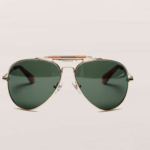
[ad_1]
“Modern life”, “Good taste”, “An elegant home”: advertisements from the 1930s announced to the four winds that modernity was breaking into Spanish homes without complexes. Now the catalogues, photographs, specialized magazines and patents from that time, together with newspaper advertisements, are some of the guiding threads of the exhibition The modern desirewhich can be visited at the National Museum of Decorative Arts in Madrid until October 23.
After two years of research, this exhibition that aspires to portray the Spanish society of the thirties through its furniture and interiors, will culminate in a catalog edited by the MNAD that will be released next autumn. The architect Pedro Feduchi and the art historian Pedro Reula have been in charge of curating the exhibition with the aim of proving that the Spain of the thirties showed glimpses of modernity in terms of furniture design and interior design, two subjects that they have always been relegated to the background compared to other disciplines such as architecture.
In the opinion of the curators, “it is essential to know how and why furniture is used in society. Sociologically and materially they are important. A chair always has a story behind it because it tells a lot about the people who used it. Looking at its design, or whether it is made of wood or steel, tells a lot about the history of a country, as is the case with art, for example, which says a lot about society”.
The appointment at the National Museum of Decorative Arts reveals the cultural change that Spain experienced from the late twenties through a selection of some of the most outstanding furniture made in that period: ten key pieces that Feduchi and Reula consider essential to understand the thirties in Spain. Each piece is a discovery due to the scarcity of surviving specimens, because they are almost unique or because they were devised by essential Spanish architects and manufacturers of the time.
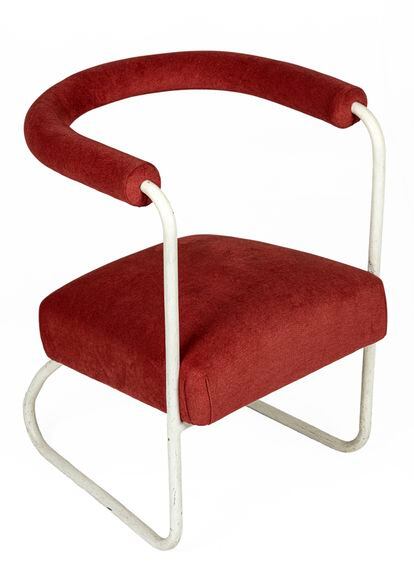
Sacha Armchair, by José Manuel Aizpurúa and Joaquín Labayen
The Sacha armchair was designed in 1930 for the Sacha Cafeteria in San Sebastián by the same architects who designed the premises, Aizpurúa and Labayen, also authors of the famous Donostia Yacht Club. This is one of the most outstanding pieces in the exhibition, as it is one of the first chairs made in Spain in curved steel tube, a novel technique that allowed the creation of these forms of continuous lines. They were manufactured by the Basque company Dámaso Azcue, specialized in natural fiber furniture, which also produced them in a wicker version for use outside the cafeteria. These armchairs belong to the collection of the architect Rafael Moneo and have been reupholstered following their original appearance based on photographs found in an article in the ABC newspaper about the exhibition. Modern architecture and paintings.
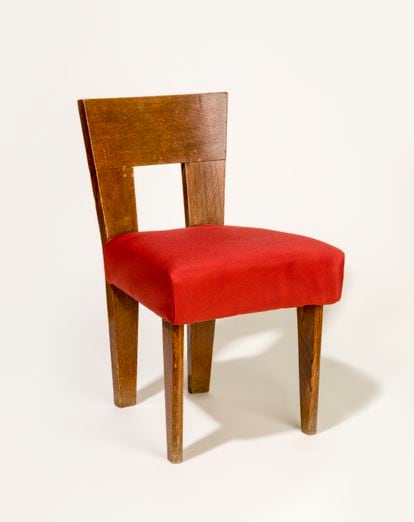
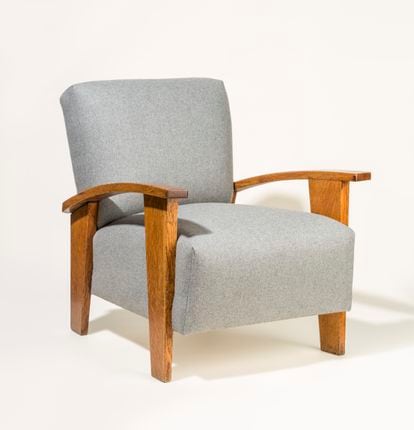
Armchair and chairs designed by the architects Carlos Arniches and Martín Domínguez
The Domínguez armchair was designed by Carlos Arniches and Martín Domínguez in 1931 for the Albergues de Carretera, a project of the time to promote tourism. It was also used in the 1990s and was reissued by the firm Punt Mobles for the rooms of the Residencia de Señoritas de la Residencia de Estudiantes in Madrid, the work of the same architects who also designed the Hipódromo de la Zarzuela, in collaboration with Eduardo Torroja. Made of oak wood and dated around 1932, “they represent a modernity closer to the Arts & Crafts movement or the style art deco Mainly due to the use of wood. It is a refinement of the popular chairs of the time because it lacks the ornamentation typical of that period in which carved ornaments were widely worn”, commented the curators.
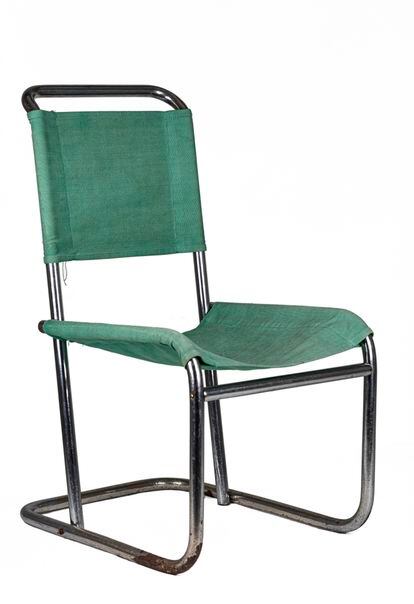
Otto Winkler chair, produced by Rolaco
Property of the MNAD, it is one of the first chairs manufactured by Rolaco, a pioneer company in Spain in the manufacture of tube furniture, founded in Madrid and with a store on Gran Vía street. It was patented in 1932 and its authorship is attributed to the German creator Otto Winkler, who was an artistic adviser to the firm. What makes it a jewel of the time is that it is a unique example of Rolaco, one of the most famous furniture makers of the moment, the result of the merger of two pre-existing companies: Mac, created by the engineers José María Fernández de Castro and Eduardo Shaw to manufacture curved steel tube furniture, and Rolaco, dedicated to the production of neon tubes and contemporary furniture.
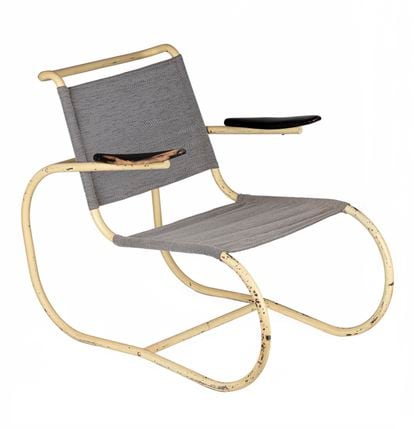
Tubular armchair produced by Rolaco
In 1933, the emergence of manufacturers of tube furniture took place in Spain, linked to the proliferation of this type of pieces in the windows of department stores, then very popular. This model is unique and little known because there is hardly any patent data. It is relevant for the modernity of its design and for the continuity traced by the curvature of the tube. There is also a rocking chair version. “It is a very expressive chair due to its austere and more organic wooden arms, and we have chosen it for its originality and the white finish instead of chrome”, commented the curators.

Armchair 163, produced by Muebles Mariner
The Armchair 163 is from Valencia, manufactured by Muebles Mariner, another company that experienced great growth in the thirties. Despite the fact that Mariner was a very prolific factory, this piece is one of the few original copies that remain from the Valencian company. It has a more special broken air than other chairs created at that time in Spain and inspired by models by Thonet, the Viennese house that pioneered the use of broken wood. “It has a very recognizable international style and a more accentuated personality”, add the curators. Its year of manufacture is unknown, although it is probably from the first half of the thirties, and it belongs to the Fundación Alfaro Hofmann collection, which has lent it for the exhibition. Mariner confirms that Valencia has always been a nerve center in furniture manufacturing. Another prominent Valencian firm was Martínez Medina (which survives, although split, at present) to which are added in other provinces, Arturo Marangoni in Barcelona, Muebles Toledo or Salvador Solá.

Desk of the Capitol Hotel, by Luis M. Feduchi
This oak table with black-stained edges, Feduchi’s hallmark, stands out for being very modern and architectural. Its shapes are reminiscent of the curved façade so characteristic of the Carrión Building in Madrid, the mythical ‘Capitol’ –for several generations of Madrid residents, the Schweppes building–, by the architects Luis Martínez Feduchi and Vicente Eced. It was designed, like all the furniture and interior design of the building, by Luis Martínez Feduchi, to whom a specific room in the exhibition is dedicated, and it is the only preserved desk. “His style moves away from the more rationalist curved steel tube furniture and has a forcefulness that is related to the architecture of Erich Mendelsohn, more expressive and closer to movement. art deco, but not far from a certain modernity”, they indicate.
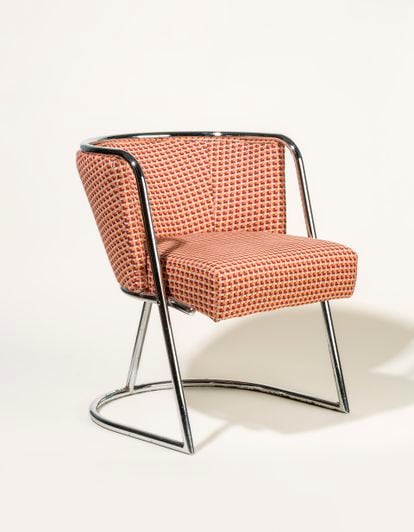
Chair for the Chicote bar, by Luis Gutiérrez Soto
This bar founded in 1931 was the first cocktail bar in Spain, opened by the bartender Perico Chicote, who commissioned a decoration art deco –today intact–, in the style of American cafes, by the prestigious architect Luis Gutiérrez Soto. Manufactured by Rolaco, it is a piece of great importance for Spanish design from the thirties, because it was one of the first curved steel chairs to be seen outside the private sphere and because it is still in use at the Museo Chicote, where you can still sit on one of these design icons in the original setting devised by the rationalist architect.
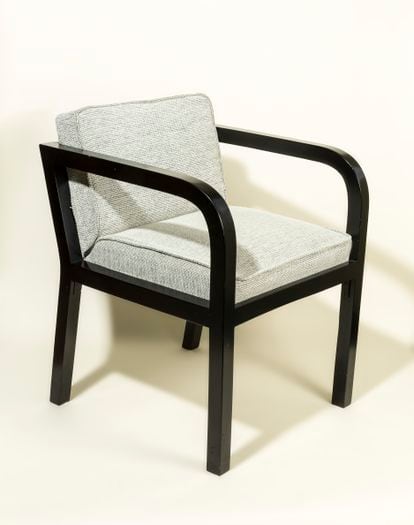
Chair for the Roca jewelry store by Josep Lluís Sert, produced by MIDVA
Josep Lluís Sert, the most famous, relevant and internationally recognized architect of the 1930s, created this chair for the Roca jewelry store in Barcelona, whose interior design also bears his signature. The historical importance of Sert’s architecture, added to the scarcity of furniture created by him, gives relevance to this chair that belongs to the collection of the National Art Museum of Catalonia. “It is one of the icons that are in the design canon of the 1930s in Spain and is possibly one of the two or three most published and widespread pieces of Spanish design” explain Pedro Feduchi and Pedro Reula. “Stylistically it is light and exemplifies pure rationalism very well, since the only ornament it has is the leg that breaks when it meets the back. This small angle constitutes a stylistic and constructive resource typical of GATCPAC, the Group of Catalan Architects and Technicians for the Progress of Contemporary Architecture, an architectural movement that emerged in 1930 led by Sert and which sought to modernize the architectural panorama”, they point out.
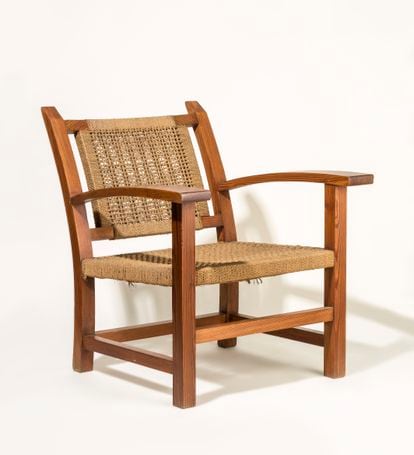
GATCPAC chair, produced by MIDVA
It is an anonymous piece, but it was most likely designed by GATCPAC members Josep Clavé, Josep Lluís Sert and Germán Rodríguez Arias. It was produced in 1936 by a company called MIDVA and was used to furnish the Spanish pavilion at the 1937 Paris International Exposition. It represents a return to popular Spanish furniture, a transition from the cold and technological stage of the curved tube to return to furniture archetypal and popular Mediterranean. His closest reference is the Mallorcan armchairs interpreted by rationalist architects.

GATCPAC desk, produced by the company Viuda de José Rivas
Desk manufactured by the company Viuda de José Rivas, one of the companies that provided the steel furniture to the GATCPAC. Very few copies of that collaboration are preserved, and this is one of them. That is why it is especially valuable.
[ad_2]
